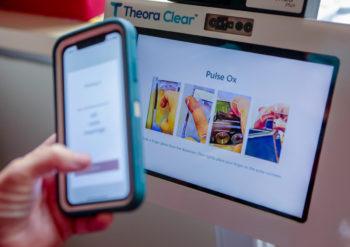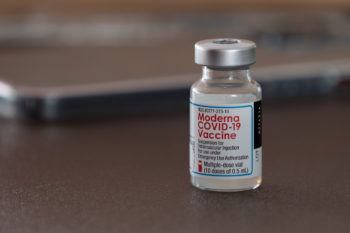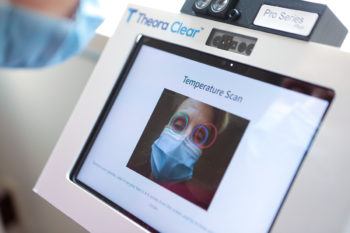Texas A&M Launches National Vaccine Study

When the average Texas A&M University student becomes infected with COVID-19, he or she often reports symptoms that are mistaken for allergies, fatigue or overwork – if they even feel sick at all.
With limited symptoms, which may cause a person to unwittingly pass the virus on to others, blame is often pointed in the direction of college students, said Rebecca Fischer, assistant professor of biostatistics and epidemiology.
“They’ve gotten a lot of flak about being spreaders as they move to and from school or while on holidays,” Fischer said. “Young adults account for a lot of coronavirus infections, and college students are getting a lot of attention as folks who are getting infected, but remain asymptomatic or have mild illness. They may not realize they are infected and can be inadvertently spreading the virus on to others.”
This makes young adults a critical population to study in order to understand transmission of COVID-19 as vaccine rollout continues. Even if the threshold of herd immunity is attained, Fischer said, it’s still unknown if the virus itself can be stopped.
Public health experts need to understand if this age group is behind a large number of infections, if transmission can be interrupted, and if further infections can be prevented. Fischer hopes to have answers to some of these questions within months through a national study to determine whether college students who receive the Moderna COVID-19 vaccine can still transmit the virus.
Fischer is a principal investigator for the study at Texas A&M, which will have more participants than any of the other 20 U.S. colleges selected for the PreventCOVIDU* program.
The national study was designed by the COVID-19 Prevention Network (CoVPN), which was formed by the National Institute of Allergy and Infectious Diseases (NIAID) at the National Institutes of Health.
Fischer said while existing vaccine efficacy studies focused on severe and symptomatic illness, hospitalization and death, this is the first study designed with the intention of looking at people with mild symptoms or who never feel sick.

“This is really important, because it’s those individuals who are out there who don’t realize they’re sick, don’t think they have a SARS-CoV-2 infection, who facilitate the spread to friends and family and neighbors,” Fischer said.
This will also be the first vaccine study in which participants are monitored daily. Students who volunteer to participate will swab their nose every day for about four months, a painless process that takes only a few seconds Although all participants will receive free testing and vaccines, they will be randomized into two groups: those who will receive immediate vaccinations, and those who will receive a delayed vaccination later in the summer and constitute a short-term comparison group representing unvaccinated individuals.
In return, student volunteers will be compensated $1,000 for their part in this important research.
“This study is really unique in that’s it’s testing everybody every single day. By doing so, we don’t miss anybody who may test positive in between weekly or bi-weekly swabs,” Fischer said. “Also, it means that we can track how much virus they have from day-to-day if they do become infected, which we hope less if vaccinated, translating to low infectiousness.”
Recruitment
Marcia Ory, regents and distinguished professor in the School of Public Health, is in charge of recruitment and community engagement for the study. She said it’s hard for most people to keep focused on a continuous topic like COVID-19, not to mention students.
But when it comes to cutting through pandemic fatigue, Ory said Texas A&M has a “secret sauce.”
“We think Aggies are more service-oriented than most college students,” she said. “The appeal is not just to get the vaccine, but to help us understand more about this condition that has turned everybody’s life upside down.”
The study’s leaders hope to appeal to students’ sense of service, asking them to help not just themselves, but society at large.
Students are being recruited from across three different sites: the flagship campus in College Station, Texas A&M-Kingsville and Texas A&M-Corpus Christi. Ory said the goal is to enroll at least 2,000 students within the coming weeks. About 1,500 will participants likely come from the College Station campus.
“We want to recruit every single eligible student in the Bryan-College Station area, so at a minimal level, any student who has not tested positive for SARS-CoV-2 and has not received a vaccine might be eligible for this study,” Fischer said
The study is recruiting students ages 18-26 who are enrolled at a participating university. Another point for interested volunteers to consider: it involves some time commitment.
On top of taking their own daily nasal swabs, volunteers will answer questionnaires in an eDiary app, provide blood samples and provide saliva twice a week.
They’ll also be asked to identify “close contacts,” who will help researchers determine if the vaccine given to participants prevents transmission of SARS-CoV-2 to others.
Additionally, Ory said students will need to be available to go to three in-person follow-up appointments on campus over the course of the study.
If Texas A&M is able to recruit its target 1,500 participants, that will make up a little more than 10 percent of the entire national study population. Fischer said this representation will be important, with Texas consistently representing about 10 percent of infections and fatalities in the United States.

Technology Innovations
The university is also unique in that it’s applying new technology and equipment toward the study.
Co-principal investigator Joy Alonzo, clinical assistant professor at the Texas A&M Irma Lerma Rangel College of Pharmacy, calls it a unique Aggie innovation. In partnership with the Texas A&M Health Science Center, the Texas A&M Engineering Experiment Station and Austin-based company Clairvoyant Networks, a kiosk with a specialized camera was created to detect temperature, the amount of oxygen in a person’s blood and their heart rate. The camera can also take a photo inside the person’s conjunctiva.
“We have a theory about people who have asymptomatic positives having some clinical markers, like a slightly elevated heart rate or a slightly decreased oxygen saturation,” “Alonzo said. “Or they might experience what’s called allergic conjunctivitis, like pink eye.”
Using a phone application called COVID Key developed by Alonzo and other A&M investigators, the kiosk’s scanning camera will identify students through a QR code. It will them walk them through the process of taking their heart rate and oxygen saturation and capturing a photo of their eye. Alonzo said information is stored in a HIPPA-compliant cloud database, along with other clinical data.
“There’s no other site in this national study that is asking these particular questions,” Fischer said. “Can we identify asymptomatic infection earlier, simply by having somebody walk up to the kiosk, taking a picture of their eye and measuring their oxygen saturation?”
Instead of researchers asking students questions, Alonzo said clinical markers will be collected from the field: “So it’s kind of a new technology. That’s a huge innovation.”
The team is partnering with Texas A&M virologists at the Global Health Research Complex lab (GHRC) to learn about how different SARS-CoV-2 variants could be implicated in breakthrough infections, which is when vaccinated individuals become infected.
Another component of the study is a youth advisory board, which will include the outgoing and incoming student body presidents. They’ll liaise with Aggies throughout the process to provide the study team with messages that will be relevant to their peers.
All case managers on the study are student employees – mostly graduate students in the School of Public Health. Fischer said the study team will be leveraging students across all three study sites while offering them practical training.
“That means that when our students are in the study and they’re enrolling and have questions, they’re actually talking to students who are trained and armed with the information,” Fischer said. “It also means that our study team can be a resource and relate to participants for problem solving and navigating the process.”
The study’s results could have implications for students’ return to campus in the fall. Experts will likely be able to answer whether vaccines will allow the campus community to forego face coverings and physical distancing and safely congregate in indoor settings.
For more information about the study and eligibility requirements, visit the PreventCOVIDU website*.
* This link is no longer active and has been removed.
Media contact: Caitlin Clark, caitlinclark@tamu.edu





